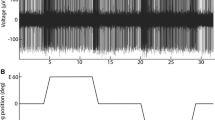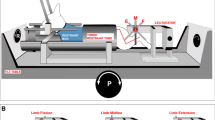Abstract
1. In decerebrate cats with the cerebellum intact we recorded the activity of lateral vestibulospinal neurons projecting to lumbosacral segments of the spinal cord (lVS neurons) and related the resting discharge, as well as the response characteristics of these neurons to roll tilt of the animal and neck rotation, with the cell size inferred from the conduction velocity of the corresponding axons. 2. A slight negative correlation was found between resting discharge rate and conduction velocity of the whole population of lVS neurons responsive and unresponsive to animal tilt and neck rotation, so that the faster the conduction velocity, the lower was the unit discharge at rest. This correlation, however, was found only for the dorsocaudal LVN neurons, which contributed to the majority of lVS units, but not for the rostroventral LVN neurons. Moreover, it affected the units unresponsive but not those responsive to vestibular stimulation; the opposite, however, occurred for the units tested to neck stimulation. These findings indicate that the static properties of the lVS neurons can only in part be related to cell size. 3. If we consider the lVS neurons responsive to roll tilt of the animal (76 neurons) and neck rotation (75 neurons) at the standard parameters of 0.026 Hz, ±10°, no significant correlation was found between gain (impulses·s−1·deg−1) of the labyrinth or neck responses and conduction velocity of the axons. Thus, due to the presence of slight negative relation between resting discharge and conduction velocity of the axons, larger neurons exhibited a greater percentage modulation (sensitivity) to the labyrinth and neck inputs than smaller neurons; this correlation involved particularly the dcLVN neurons. These findings suggest that the afferent pathways driven during dynamic stimulation of labyrinth and neck receptors produce an higher number or density of synaptic contacts on lVS neurons of increasing size. 4. No significant differences in the means of resting discharge, conduction velocity, gain and sensitivity were found between all the lVS units responding to labyrinth and neck inputs. These findings indicate that the effectiveness of the two inputs was almost comparable and did not vary in different units as a function of cell size. 5. The lVS neurons were mainly excited during side-down animal tilt and side-up neck rotation. Although these neurons showed the same spectrum of conduction velocity as those displaying the opposite response patterns, the response gains of the predominant populations of units were on the average higher than those obtained from the remaining populations of units. The peak of the unit responses occurred with an average phase lead of +21.0±27.2°, SD with respect to the extreme animal displacements, and an average phase lead of +52.0±18.3, SD with respect to the extreme neck displacements; yet no difference was found in the average phase angle of responses of the two populations of slow and fast units to animal tilt or neck rotation. These findings indicate that the quantitative and qualitative organization of the synaptic inputs represent the critical factor controlling response characteristics of comparable size lVS neurons to vestibular and neck stimulations. 6. A comparison between the present results and those obtained in previous experiments performed after bilateral ablation of the paleocerebellum permitted to evaluate the role that the inhibitory area of the cerebellum exerts on the resting discharge, as well as on the dynamic characteristics of response of different size lVS neurons to animal tilt and neck rotation.
Similar content being viewed by others
References
Akaike T (1983) Electrophysiological analysis of cerebellar corticovestibular and fastigiovestibular projections to the lateral vestibular nucleus in the cat. Brain Res 272:223–235
Akaike T, Fanardjian VV, Ito M, Nakajima H (1973) Cerebellar control of the vestibulospinal tract cells in rabbit. Exp Brain Res 18:446–463
Anderson JH, Blancks RHI, Precht W (1978) Response characteristics of semicircular canal and otolith systems in cat. I. Dynamic response of primary vestibular fibers. Exp Brain Res 32:491–507
Boyle R, Pompeiano O (1981) Cerebellar influences on the response characteristics of vestibulospinal neurons to sinusoidal tilt. Arch Ital Biol 119:208–225
Boyle R, Pompeiano O (1981) Convergence and interaction of neck and macular vestibular inputs on vestibulospinal neurons. J Neurophysiol 45:852–868
Boyle R, Pompeiano O (1981) Relation between cell size and response characteristics of vestibulospinal neurons to labyrinth and neck inputs. J Neurosci 1:1052–1066
Boyle R, Pompeiano O (1981) Response of vestibulospinal neurons to neck and macular inputs in the presence or absence of the paleocerebellum. Ann NY Acad Sci 374:373–394
Burke RE (1967) Motor unit types of cat triceps surae muscle. J Physiol (Lond) 193:141–160
Burke RE (1968) Group Ia synaptic input to fast and slow twitch motor units of cat triceps surae. J Physiol (Lond) 196:605–630
Burke RE (1968) Firing patterns of gastrocnemius motor units in the decerebrate cat. J Physiol (Lond) 196:631–654
Burke RE (1973) On the central nervous system control of fast and slow twitch motor units. In: Desmedt JE (ed) New developments in electromygraphy and clinical neurophysiology, vol 3. Karger, Basel, pp 69–94
Burke RE (1979) The role of synaptic organization in the control of motor unit activity during movement. In: Granit R, Pompeiano O (eds) Progress in brain research, vol 50. Reflex control of posture and movement. Elsevier, Amsterdam, pp 61–67
Burke RE, ten Bruggengate G (1971) Electrotonic characteristics of alpha motoneurons of varying size. J Physiol (Lond) 212:1–20
Burke RE, Rudomín P (1977) Spinal neurons and synapses. In: Kandel ER (ed) Handbook of physiology, sect 1: The nervous system, vol I. Cellular biology of neurons, part 1. American Physiological Society, Bethesda, pp 877–944
Clamann HP, Gillies ID, Henneman E (1974) Effects of inhibitory inputs on critical firing level and rank order of motoneurons. J Neurophysiol 37:1350–1360
Cohen LA (1961) Role of eye and neck proprioceptive mechanisms in body orientation and motor coordination. J Neurophysiol 24:1–11
Cooper S, Daniel PM (1963) Muscle spindles in man: their morphology in the lumbrical and the deep muscles of the neck. Brain 80:563–586
Corvaja N, Pompeiano O (1979) Identification of cerebellar corticovestibular neurons retrogradely labeled with horseradish peroxidase. Neuroscience 4:507–515
Denoth F, Magherini PC, Pompeiano O, Stanojević M (1979) Responses of Purkinje cells of the cerebellar vermis to neck and macular inputs. Pflügers Arch 381:87–98
Denoth F, Magherini PC, Pompeiano O, Stanojević M (1980) Responses of Purkinje cells of cerebellar vermis to sinusoidal rotation of neck. J Neurophysiol 43:46–59
Eccles JC, Eccles RM, Iggo A, Ito M (1961) Distribution of recurrent inhibition among motoneurones. J Physiol (Lond) 159:479–499
Fanardjian VV, Sarkissian VA (1980) Spatial organization of the cerebellar corticovestibular projection in the cat. Neuroscience 5:551–558
Friedman WA, Sypert GW, Munson JB, Fleshman JW (1981) Recurrent inhibition in type-identified motoneurons. J Neurophysiol 46:1349–1359
Harris DA, Henneman E (1979) Different species of alpha motoneurons in same pool: Further evidence from effects of inhibition on their firing rates. J Neurophysiol 42:927–935
Hellon RF (1971) The marking of electrode tip positions in nervous tissue. J Physiol (Lond) 214:12P
Henneman E, Mendell LM (1981) Functional organization of motoneuron pool and its inputs. In: Brooks VB (ed) Handbook of physiology, sect 1. The nervous system, vol II: Motor control, part 1. American Physiological Society, Bethesda, Maryland, pp 423–507
Henneman E, Somjen G, Carpenter DO (1965) Excitability and inhibitility of motoneurons of different sizes. J Neurophysiol 28:599–620
Henneman E, Clamann HP, Gillies ID, Skinner RD (1974) Rank order of motoneurons within a pool: Law of combination. J Neurophysiol 37:1338–1349
Hultborn H, Pierrot-Deseilligny E, Wigström H (1978) Distribution of recurrent inhibition within a motor nucleus. Neurosci Lett (Suppl 1):S97
Ito M (1972) Cerebellar control of the vestibular neurons: physiology and pharmacology. In: Bródal A, Pompeiano O (eds) Progress in brain research, vol 37. Basic aspects of central vestibular mechanisms. Elsevier, Amsterdam, pp 377–390
Itoh M, Yoshida M (1966) The origin the cerebellar-induced inhibition of Deiters neurones. I. Monosynaptic initiation of the inhibitory post-synaptic potentials. Exp Brain Res 2:330–349
Ito M, Obata K, Ochi R (1966) The origin of cerebellar-induced inhibition of Deiters neurons. II. Temporal correlation between the trans-synaptic activation of Purkinje cells and the inhibition of Deiters neurons. Exp Brain Res 2:350–364
Ito M, Kawai N, Udo M (1968) The origin of cerebellar-induced inhibition of Deiters neurones. III. Localization of the inhibitory zone. Exp Brain Res 4:310–320
Kernell D (1966) Input resistance, electrical excitability and size of ventral horn cells in cat spinal cord. Science 152:1637–1640
Kuno M (1950) Excitability following antidromic activation in spinal motoneurones supplying red muscles. J Physiol (Lond) 149:374–393
Marchand AR, Manzoni D, Pompeiano O, Stampacchia G (1987) Effects of stimulation of vestibular and neck receptors on Deiters neurons projecting to the lumbosacral cord. Pflügers Arch 409:13–23
McCouch GP, Deering ID, Ling TH (1951) Location of receptors for tonic neck reflexes. J Neurophysiol 14:191–195
Mendell LM, Henneman E (1971) Terminals of single I a fibers: Location, density and distribution within a pool of 300 homonymous motoneurons. J Neurophysiol 34:171–187
Pompeiano O (1984) Recurrent inhibition. In: Davidoff RA (ed) Handbook of the spinal cord, vols 2 and 3. Anatomy and physiology. Marcell Decker, New York Basel, pp 461–557
Pompeiano O, Brodal A (1957) The origin of vestibulospinal fibers in the cat. An experimental-anatomical study, with comments on the descending medial longitudinal fasciculus. Arch Ital Biol 95:166–195
Precht W (1974) The physiology of the vestibular nuclei. In: Kornhuber HH (ed) Handbook of sensory physiology, vol VI. Vestibular system, part 1: Basic mechanisms. Springer, Berlin Heidelberg New York, pp 353–416
Richmond FJR, Abrahams VC (1975) Morphology and distribution of muscle spindles in dorsal muscles of the cat neck. J Neurophysiol 38:1322–1339
Richmond FJR, Bakker DA (1982) Anatomical organization and sensory receptor content of soft tissues surrounding upper cervical vertebrae in the cat. J Neurophysiol 48:49–61
Shimazu H, Precht W (1965) Tonic and kinetic responses of cat's vestibular neurons to horizontal angular acceleration. J Neurophysiol 28:991–1013
Stanojević M (1981) Responses of cerebellar fastigial neurons to neck and macular vestibular inputs. Pflügers Arch 391:267–272
Stanojević M, Erway B, Ghelarducci B, Pompeiano O, Willis WD Jr (1980) A comparison of the response characteristics of cerebellar fastigial and vermal cortex neurons to sinusoidal stimulation of macular vestibular receptors. Pflügers Arch 385:95–104
Stuart DG, Enoka RM (1983) Motoneurons, motor units, and the size principle. In: Rosenberg RN (ed) The clinical neurosciences, sect 5. Neurobiology (Willis WD, ed). Churchill Livingstone, New York, pp 471–517
Wand P, Pompeiano O, Fayein NA (1980) Impulse decoding process in extensor motoneurones of different size during the vibration reflex. Arch Ital Biol 118:205–242
Zucker RS (1973) Theoretical implications of the size principle of motoneuron recruitment. J Theor Biol 38:587–596
Author information
Authors and Affiliations
Rights and permissions
About this article
Cite this article
Pompeiano, O., Manzoni, S., Marchand, A.R. et al. Effects of roll tilt of the animal and neck rotation on different size vestibulospinal neurons in decerebrate cats with the cerebellum intact. Pflugers Arch. 409, 24–38 (1987). https://doi.org/10.1007/BF00584746
Received:
Accepted:
Issue Date:
DOI: https://doi.org/10.1007/BF00584746




